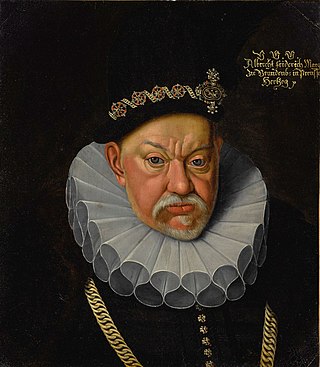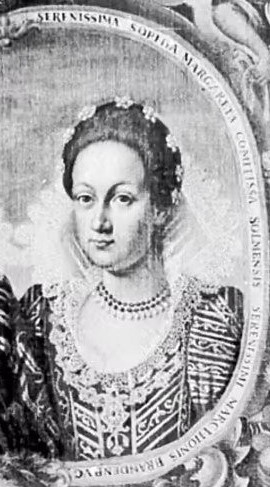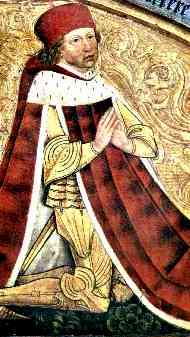
Albert Frederick was the Duke of Prussia, from 1568 until his death. He was a son of Albert of Prussia and Anna Marie of Brunswick-Lüneburg. He was the second and last Prussian duke of the Ansbach branch of the Hohenzollern family.

The House of Hohenzollern is a formerly royal German dynasty whose members were variously princes, electors, kings and emperors of Hohenzollern, Brandenburg, Prussia, the German Empire, and Romania. The family came from the area around the town of Hechingen in Swabia during the late 11th century and took their name from Hohenzollern Castle. The first ancestors of the Hohenzollerns were mentioned in 1061.

Albrecht III was Elector of Brandenburg from 1471 until his death, the third from the House of Hohenzollern. A member of the Order of the Swan, he received the cognomen Achilles because of his knightly qualities and virtues. He also ruled in the Franconian principalities of Ansbach from 1440 and Kulmbach from 1464.

John Frederick, Margrave of Brandenburg-Ansbach succeeded his father Albert II as margrave of Ansbach in 1667. He married his second wife Princess Eleonore Erdmuthe of Saxe-Eisenach on 4 November 1681. Their daughter Wilhelmine Charlotte Caroline, Margravine of Brandenburg-Ansbach married George II of Great Britain before he became king.

The Principality or Margraviate of (Brandenburg) Ansbach was a free imperial principality in the Holy Roman Empire centered on the Franconian city of Ansbach. The ruling Hohenzollern princes of the land were known as margraves, as their ancestors were margraves.

The Principality of Bayreuth or Margraviate of Brandenburg-Bayreuth was an immediate territory of the Holy Roman Empire, ruled by a Franconian branch of the Hohenzollern dynasty. Since Burgrave Frederick VI of Nuremberg was enfeoffed with the Margraviate of Brandenburg in 1415/17, the Hohenzollern princes transferred the margravial title to their Franconian possessions, though the principality never had been a march. Until 1604 they used Plassenburg Castle in Kulmbach as their residence, hence their territory was officially called the Principality of Kulmbach or Margraviate of Brandenburg-Kulmbach until the Empire's dissolution in 1806.

George Frederick II, also called George Frederick the Younger, was Margrave of Brandenburg-Ansbach from 6 October 1692 until his death in 1703. He was the third son of John Frederick, Margrave of Brandenburg-Ansbach by his first wife Joanna Elisabeth of Baden-Durlach. George Frederick succeeded his elder brother Christian Albert as Margrave in 1692.

The Burgraviate of Nuremberg was a state of the Holy Roman Empire from the early 12th to the late 15th centuries. As a burgraviate, it was a county seated in the town of Nuremberg; almost two centuries passed before the burgraviate lost power over the city, which became independent from 1219. Eventually, the burgraviate was partitioned to form Brandenburg-Ansbach and Brandenburg-Bayreuth.

Frederick Charles of Württemberg-Winnental was since 1677 Duke of the new-founded line of Württemberg-Winnental and regent of the infant Duke Eberhard Ludwig.

Christian Friedrich Carl Alexander was the last margrave of the two Franconian principalities, Bayreuth and Ansbach, which he sold to the King of Prussia, a fellow member of the House of Hohenzollern.
Christian Heinrich of Brandenburg-Bayreuth-Kulmbach, was a German prince and member of the House of Hohenzollern and nominal Margrave of Brandenburg-Bayreuth-Kulmbach.
Starting in the 12th century, the Margraviate, later Electorate, of Brandenburg was in conflict with the neighboring Duchy of Pomerania over frontier territories claimed by them both, and over the status of the Pomeranian duchy, which Brandenburg claimed as a fief, whereas Pomerania claimed Imperial immediacy. The conflict frequently turned into open war, and despite occasional success, none of the parties prevailed permanently until the House of Pomerania died out in 1637. Brandenburg would by then have naturally have prevailed, but this was hindered by the contemporary Swedish occupation of Pomerania, and the conflict continued between Sweden and Brandenburg-Prussia until 1815, when Prussia incorporated Swedish Pomerania into her Province of Pomerania.

Princess Eleonore Erdmuthe Louise of Saxe-Eisenach was a member of the House of Wettin and through her two marriages became Margravine of Brandenburg-Ansbach and Electress of Saxony.

Albert II or V of Brandenburg-Ansbach was a German prince, who was Margrave of Ansbach from 1634 until his death.

Joachim Ernst, Margrave of Brandenburg-Ansbach was a German nobleman. He ruled as margrave of Brandenburg-Ansbach from 1603 to 1625, succeeding his cousin George Frederick and succeeded by his son Frederick III.

William Frederick, Margrave of Brandenburg-Ansbach, was Margrave of the Principality of Brandenburg-Ansbach from 1703 until his death in 1723. He was the younger brother of Caroline of Ansbach and thus brother-in-law of George II of Great Britain.

Christiane Charlotte of Württemberg-Winnental was a German princess and regent. She was regent of Brandenburg-Ansbach in 1723-1729.

Sophie of Solms-Laubach, was a German regent, Margravine of Brandenburg-Ansbach by marriage to Joachim Ernst, and regent during the minority of her son from 1625 until 1639.

The Dispositio Achillea was the disposition of the territories of Elector Albert III Achilles of Brandenburg as regulated in his last will and testament of 1473.
The House Treaty of Regensburg was a treaty concluded on 23 July 1541 between two branches of the House of Hohenzollern, defining the boundaries between the newly created principalities of Ansbach and Kulmbach. These two territories had been created when in 1486 the Burgraviate of Nuremberg had been divided according to the Dispositio Achillea.
















